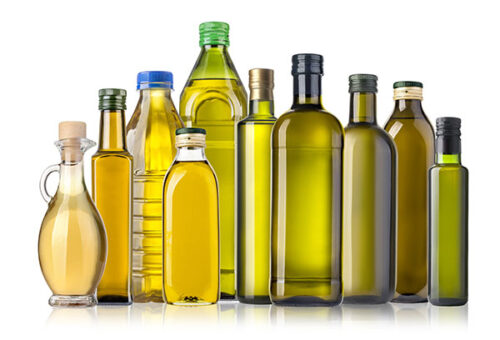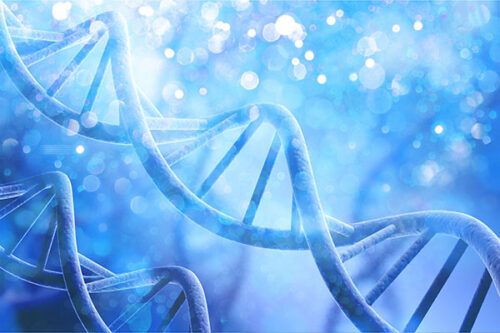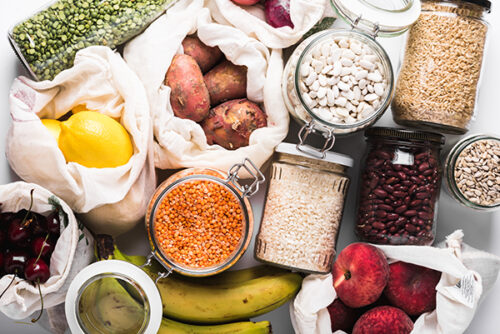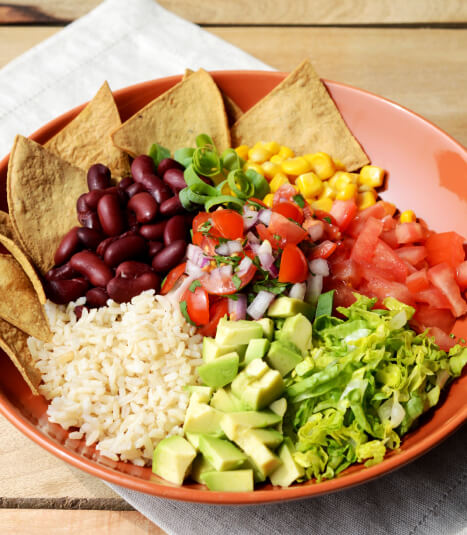One Thing to Work on This Year

A New Year’s Resolution Based on Four Decades of Success
If you are looking for big improvements in your life then your diet is the right place to focus. In the late 1970s, when Dr. McDougall was developing the McDougall Diet after reading the bulk of the nutritional science published since the early 1900s, he came to the conclusion that starches, vegetables and fruits were ideal for human nutrition. These humble plant parts supplied all of the calcium, iron and high-quality protein that any person of any age, beyond infancy (a time for breast milk), would ever need during any activity, including those as demanding as pregnancy and running triathlons.
The Relative Hazards of Foods
However, you may be thinking you are unwilling or unable to make a complete turn-around to the diet we recommend based on starches, vegetables and fruits, all of the time. In that case, you should consider a more gradual course by eliminating foods based on the categories outlined in Dr. McDougall’s first national best-selling book The McDougall Plan (1983). We have made a few modifications in order to update the lists in the categories below.
Progression from Categories I through IV below lead from harmful to health-supporting foods. For those who usually follow the diet closely, these categories will identify foods least damaging to you when you do indulge on those special occasions. Anyone who is not yet ready for a complete change to a health-supporting diet as set forth in Category IV may want to improve his or her diet by beginning with the elimination of foods in Category I and progressing at his or her own pace.
Category 1 — Dangerous Foods
You should never eat these foods. Government, medical and scientific authorities have considered these foods dangerous enough to hold committee hearings, to issue warnings about them, or even to ban these products from use. All of these foods are suspected causes of cancer. You have no reason to eat these, because there are safer alternatives.
- Nitrite-containing meats: ham, hot dogs, sausages, cold cuts, and bacon
- Supermarket quality meat: pork, beef, organ meats, and poultry. They are contaminated with substances that are suspected of causing birth defects and cancers
- Hydrogenated and partially hydrogenated vegetable oils: margarines, vegetable shortenings: found in most packaged foods from cookies to breath mints
- Charcoal-broiled and smoked foods
- Deep-fried foods
Category II — Feast Foods
IIA. These foods should be eaten rarely, if ever. Never eat them if you are trying to regain your lost health and appearance. These are very rich foods. They should be reserved for that special occasion, the feast. For most healthy people, these feasts should occur less than once a month. Anyone still trying to regain the best possible level of health should always avoid feasts. Be forewarned: for some sensitive people, like those with inflammatory arthritis, one feast can result in devastating pains lasting for weeks.
- Range-fed beef without hormones or chemicals
- Organically grown poultry
- Shellfish
- Fresh fish
- Cream
- Whole milk
- Cheese
- Creamed cottage cheese
- Sour cream
- Ice Cream
- Yogurt
- Butter
- Eggs
- Vegetable oils (including olive oil, flaxseed oil, canola oil, coconut and all “free” oils)
IIB. These modified feast foods should be eaten no more than once a week, and then only in small amounts. Anyone looking for improvement in their health should never eat them. These dairy and egg foods have been modified to lower the fat and cholesterol content. Removal of the fat reduces the level of fat-soluble chemical contaminants. However, they are still too high in animal protein, and contain no dietary fiber. Dairy products are the leading cause of food allergies, and eggs are often listed as the second most common food allergen.
- Low-fat yogurt
- Low-fat milk (skim milk)
- Buttermilk
- Low-fat (dry curd) cottage cheese
- Low-fat cheese (like mozzarella)
- Kefir
- Sherbet (contains water, sugar, fruit juice, and often egg whites or low-fat dairy products)
- Egg whites
Category III — Rich Plant Foods
These rich plant foods may account for a small portion of your daily food intake (less than 10 percent of your calories per day) but only after you have attained the level of health you are striving for. In general, these foods are more harmful than health-supporting. Never eat these foods if you have problems with your health that remain unresolved. They can easily add to your body fat. If you begin using this group of foods and find that you are also gaining weight or getting back some of your old ailments, then stop eating these foods immediately.
IIIA. High-fat plant foods contain large amounts of fat, and are very high in calories.
- Olives
- Avocados
- Nuts
- Nut butters (like peanut butter)
- Seeds
- Seed spreads (like tahini)
- Soybeans
- Tofu (fiber has also been removed)
- Tempeh
- Miso
- Non-dairy “ice cream”
- Coconut meat
- Chocolate (dairy-free)
IIIB. Simple sugar foods provide concentrated calories and often little else.
- White sugar
- Brown sugar
- Corn syrup
- Honey
- Maple syrup
- Molasses
- Malt syrup
- Agave nectar
- Sorbet
- Jams and jellies
- Fruit puree (like applesauce — significant content of vitamins and minerals)
- Dried fruit (best) (significant content of fiber, vitamins and minerals)
IIIC. Refined grains and flours have had much of their fiber content, vitamins and minerals removed. Some products have had a few vitamins and minerals added back (enrichment).
- White rice (cereal- or glucose-coated)
- Refined flours (such as white flour, used in bread, bagels and noodle products)
- Cornstarch
- Potato starch
Category IV — Health-Supporting Foods
These foods are health-supporting. They allow your body to attain and maintain its naturally intended state of good health. They should account for the greatest share (at least 90 percent) of your calories if you are healthy and for all of them if you are still working to regain your health.
- Whole grains, such as wheat, rice, barley, millet, rye, oats, corn and popcorn
- Milled grains, such as whole-wheat flour, cornmeal, brown rice flour, rye flour, oatmeal and bulgur
- Starchy vegetables, such as white potatoes, sweet potatoes, yams and cassava
- Colorful vegetables, such as spinach, kale, zucchini, broccoli, cabbage, carrots and onions
- Sprouted seeds and beans, such as alfalfa, radish, wheat, mung beans and lentils
- Beans, peas, lentils, such as kidney beans, white beans, garbanzo beans, pinto beans, split peas and red lentils. (These legumes are high-protein. They should be restricted to about one cup of cooked food on average daily and restricted even more for people with osteoporosis, kidney stones, and liver or kidney failure.)
- Fresh fruits
Ten Ideas We Have Improved On in Four Decades:
You should not be surprised to learn that we got it mostly right the first time — more than 40 years ago. After six years of exhaustive study of the scientific research and almost every vegetarian cookbook published in the preceding eighty years we learned a lot from other people’s hard work. During those six years between 1977 and 1983 when The McDougall Plan was being written, we also designed homey recipes, cooked the meals, and the McDougall family taste-tested each and every one of them. Here is what we can now add:
1) Animal foods — be they derived from cow, pig, chicken, or fish muscles or the ovum of a bird or the lactation fluids of a mammal — high-fat or low-fat — are all so similar in their make-up that they must be considered together, and should be strictly avoided for health reasons. The destruction of the Earth due to the livestock industry makes avoiding animal foods imperative.
2) Chicken and Turkey are no improvement over beef and pork products. Consumers are just fooling themselves and might as well have a beefsteak on their birthday rather than a dried-up piece of white breast meat.
3) Fish are health-wise no better than any of the other muscle foods. Since the time The McDougall Plan was written nearly 90% of the world’s large fish and other sea life have vanished. In order to restore our oceans, lakes and streams people must understand the importance of not eating and further contributing to the depletion of these natural resources.
4) Low-fat Dairy Products and Egg Whites are very high in animal protein and sulfur-containing amino acids, which promote bone, kidney and liver damage. Trading high-fat foods for low-fat foods in this category makes no difference to your health.
5) Soy Foods, such as traditional soymilk, tofu and miso are sensible additions to a healthy diet, but should be used in small amounts because they are rich in fat and protein. Fake foods, such as soy burgers, soy luncheon meats, soy hot dogs and soy cheeses made from isolated soy proteins and a number of other chemicals should be strictly avoided.
6) Vegetable Oils, regardless of the health claims, such as “high in omega-3s” or “good fats” are serious health hazards and should be clearly distinguished from whole foods that are high in vegetable fats such as nuts, seeds, avocados and olives.
7) Salt is a pleasurable taste that can make compliance with the McDougall Diet much easier. Research over the past three decades shows salt is well tolerated by most people and rarely is a contributor to poor health. However, to be on the cautious side, use salt sparingly.
8) Simple Sugars are all basically the same and make foods delicious. Used sparingly they add great pleasure to the McDougall Diet without causing harm.
9) A Starch Focus is emphasized in every possible way. The McDougall Diet has always been taught as a starch-based diet with the addition of fresh or frozen vegetables and fruits. Until people eat most of their calories from higher-calorie plant foods, such as rice, corn, beans and potatoes, they struggle. Emphasizing these comfort foods makes everything about the McDougall Program work easily.
10) Simplicity in meals is a key to better health and appearance. Dishes such as sweet potatoes and broccoli or rice with steamed green veggies, which are topped with delicious sauces can make an easy and complete meal. With simplicity, advantages like greater weight loss, better health and lower food costs are enjoyed.
Happy New Year!
Recommended Articles

When Friends Ask: Why Do You Avoid Adding Vegetable Oils?

Human Genes are Turned On and Off by Diet







